United States Grand Prix
| Circuit of the Americas | |
 | |
| Race information | |
|---|---|
| Number of times held | 46 |
| First held | 1908 |
| Most wins (drivers) |
|
| Most wins (constructors) |
|
| Circuit length | 5.516 km (3.427 mi) |
| Race length | 308.896[1] km (191.939 mi) |
| Laps | 56[1] |
| Last race (2016) | |
| Pole position | |
| |
| Podium | |
| |
| Fastest lap | |
| |
The United States Grand Prix is a motor race which has been held in the U.S. on and off since 1908, when it was known as the American Grand Prize. The race later became part of the Formula One World Championship. Over 44 editions of the race have taken place at 10 locations in total. Since 2012, it has been held at the Circuit of the Americas in Elroy, Texas (12 miles (19 km) south of Austin).
History
Origins
Beginnings and the Vanderbilt Cup
Inspired by the Gordon Bennett Cup and Circuit des Ardennes races he had competed in, William Kissam Vanderbilt founded a series of road races in the United States to showcase American road racing to the world. The Vanderbilt Cup soon became an institution on New York's Long Island, attracting American and European competitors alike. However, the race was plagued by crowd control problems, which led to spectator deaths and injuries, and the cancellation of the 1907 event. Upon its return for 1908, the American Automobile Association did not adopt the new Grand Prix regulations agreed upon by the Association Internationale des Automobiles Clubs Reconnus (AIACR).[2][3] This led the rival Automobile Club of America, an enthusiasts group with strong ties to Europe, to sponsor the American Grand Prize, using the Grand Prix rules.[4] The Savannah Automobile Club of Savannah, Georgia about 2 hours north of Jacksonville, Florida had staged a successful stock car race in the spring, won the rights to stage the event.[5]
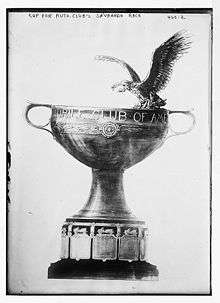
The Grand Prize era
The Savannah Automobile Club laid out a lengthened version of their stock car course, totaling 25.13 mi (40.44 km). Georgia Governor M. Hoke Smith authorized the use of convict labor to construct the circuit of oiled gravel. The Governor also sent state militia troops to augment local police patrols in keeping the crowd in check, hoping to avoid the pitfalls of the Vanderbilt Cup races.[5] The entry for the inaugural race featured 14 European and six American entries, including factory teams from Benz, Fiat, and Renault.[6] In the race, held on Thanksgiving Day, Ralph DePalma led early in his Fiat, before falling back with lubrication and tire problems. The race came down to a three-way battle between the Benz of Victor Hémery and the Fiats of Louis Wagner and Felice Nazzaro. Wagner won the race by the close margin of 56 seconds.[7]
Despite the success of the Savannah event, it was decided that the 1909 race would be held on Long Island, in conjunction with the Vanderbilt Cup. However, only the Vanderbilt race was held and the Grand Prize pushed back to the next year. After the 1910 Vanderbilt Cup saw more issues, including the deaths of two riding mechanics and several serious spectator injuries, the Grand Prize was cancelled once again. A last-minute request by the Savannah club saved the race for the year, but only gave one month to prepare the course. A shorter 17-mile (27 km) course was laid out, but due to the short notice, most European teams were not able to make the trip. The leading trio from 1908 did make it and American David Bruce-Brown joined the Benz squad. Bruce-Brown won another incredibly tight race over teammate Hémery, this time by only 1.42 seconds.[8] The 1911 event returned to Savannah, and this time the Vanderbilt Cup came with it; the Cup and Grand Prize were to be held together until 1916. Despite the success of the events, public pressure started to mount on the organizers. The use of convict labor and the militia drew criticism, as did the nuisance of closing roads for the event.[9] Two accidents on the open roads in practice, one resulting in the death of Jay McNay, cast a shadow over the event. The American entries dominated the support events and ran well throughout the Grand Prize, after poor showings in past years and once again Bruce-Brown triumphed, this time driving a Fiat.[10]
For 1912, Savannah succumbed to public pressure, and Milwaukee, Wisconsin, won the bid for the race. A narrow, 7.88-mile (12.68 km) trapezoidal course was set up on the outskirts of the city, in Wauwatosa. As in 1911, tragedy struck in practice when David Bruce-Brown was killed after a puncture sent him off the road. On the final lap of the race, Ralph DePalma collided with eventual winner Caleb Bragg, seriously injuring DePalma and his mechanic and ending any chance of a second race at Milwaukee.[11]
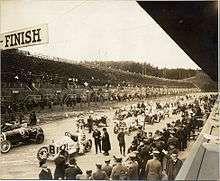
The Grand Prize was not held in 1913, after Long Island's bid was rejected and Savannah refused to provide sufficient prize money. Oval racing on board tracks had taken off in the United States, to the detriment of road racing. For 1914, the Grand Prize and Vanderbilt Cup were staged in Santa Monica, California near Los Angeles, on an 8.4-mile (13.5 km) course, with the start/finish straight along the Pacific Ocean. The field was primarily American entries (twelve, against five European entries), and the Americans dominated, with Eddie Pullen's Mercer winning by over 40 seconds.[12] In 1915, the race shifted to San Francisco, in conjunction with the Panama–Pacific International Exposition. With the outbreak of World War I in Europe, almost all of the drivers and cars were American, except for a few cars imported earlier. The 3.84-mile (6.18 km) course was set up around the Exposition grounds and nearby oval track with a boarded main straightaway. Heavy rain began two hours into the race, covering the circuit in mud from the extensive flower arrangements, and warping the main straight's boards. Dario Resta in a Peugeot cruised to a seven-minute victory, and followed up a week later by winning the Vanderbilt Cup.[13] For 1916, the Grand Prize returned to Santa Monica. The race would be a part of the AAA National Championship, which carried a 4.91-liter displacement limit. Although the limit for the Grand Prize was 7.37 liters, no large-displacement cars would enter. The race was the penultimate round of the championship, with Dario Resta leading Johnny Aitken after his Vanderbilt Cup win. However, both cars would be out before halfway. Although Aitken took over teammate Howdy Wilcox's car for the win, the AAA awarded points only to Wilcox, and Resta took the championship.[14][15]
Post-war decline and the Indianapolis 500
The Grand Prize was discontinued after the 1916 event. Between a lack of European participation due to World War I and the growing American interest in oval racing, road racing fell by the wayside. The two Santa Monica events were the only road races on the 1916 championship, and the aborted 1917 National Championship was slated to feature 8 events, all ovals and six of them board tracks.[16] The Vanderbilt Cup was revived in 1936 and 1937 and run to Grand Prix regulations; these races were run at the Roosevelt Park Autodrome near New York City but a lack of competition and domination by German Bernd Rosemeyer and Italian Tazio Nuvolari led to the races being a commercial failure.
The Indianapolis 500 kept a connection to European racing, running to Grand Prix regulations between 1923 and 1930,[2] and from 1938 until 1953.[17] In the late 1920s, efforts were made to refer to the 500 as the American Grand Prize.[18] The Grand Prize trophy was awarded to the winner of the Indianapolis 500 between 1930[19] and 1936, when it was replaced by the Borg-Warner Trophy. The race was included in the World Championship from 1950 through 1960.
Sebring and Riverside
Riverside International Raceway opened in Riverside, California, in 1957 and one of its first events was an SCCA National sports car race. For 1958, the race moved to the new, professional, USAC Road Racing Championship, and was billed as the "United States Grand Prix".[17][20] The race attracted over 50 cars and drivers from sports car series in the U.S. and Europe, as well as USAC and NASCAR. Chuck Daigh won in a Scarab, beating Dan Gurney's Ferrari in second place.[21][22]
Russian-born Alec Ulmann staged the first 12 Hours of Sebring endurance race in 1952 at the airport (converted over from World War II use) of the rather isolated central Florida town of Sebring, located 1 1/2 hours south of Orlando and Tampa, and 3 hours north of Miami. The track was formed using service roads and runways of Sebring's airport, and it became a round of the World Sportscar Championship in 1953. Buoyed by the success of the 12 Hours, the Riverside sports car race and Formula Libre events at Watkins Glen and Lime Rock Park, Ulmann decided to stage a Formula One race at Sebring International Raceway in 1959. The race was billed as the "II United States Grand Prix",[23] cementing the Riverside race as a part of the Grand Prix's heritage. The race was originally scheduled for March 22, the day after the 12 Hour-race, but rescheduled for December 12, the final round of the season.[24] The race took place 3 months after the previous round at Monza. The starting grid included seven American drivers, but New Zealand's Bruce McLaren, in a Cooper, took his first win in F1 and was, at the time, the youngest driver ever to win a Grand Prix. McLaren took the lead on the last lap of the race when his team-mate, Jack Brabham, ran out of fuel. Brabham had to push his car over the line to finish fourth. By virtue of Ferrari's Tony Brooks finishing third, Brabham and Cooper took the Drivers' and Constructors' championships, respectively.[25] Despite providing an exciting climax to the season, the race was not successful from the hosts' standpoint, the race's isolated location did not help the event's success as the promoters barely broke even. When prize money checks bounced, Charles Moran and Briggs Cunningham paid the money to save face for their country.[17]
Ulmann moved the race to the Riverside International Raceway in Riverside, California an hour east of Los Angeles for 1960. Stirling Moss put on quite a show in his privately entered Lotus by winning from pole position. However, while the driver's purse was enormous (as at Sebring), the event was no better received than the previous year's due to a lack of promotion, and proximity to the successful Times Grand Prix.[20] Again Moran and Cunningham would pay the prize money.[17]
Watkins Glen
Through most of 1961, Ulmann was listed as the promoter of the USGP, and contacted organizers in Miami and Bill France of the Daytona International Speedway but was unable to reach agreements. In August, racing promoter Cameron Argetsinger, owner of the 2.35-mile (3.78 km) Watkins Glen Grand Prix Race Course located in the central Finger Lakes region of upstate New York, offered his circuit to the Automobile Competition Committee for the United States (ACCUS) to host the Grand Prix. He succeeded and Watkins Glen would host the United States Grand Prix for the next 20 years. Over this time, the event became a tradition among the fans as loyal crowds gathered each autumn on the spread out hills of Upstate New York. It was one of the season's most popular events with the teams and drivers as well, receiving the Grand Prix Drivers' Association award for the best organized and best staged Grand Prix of the season in 1965, 1970, and 1971. The isolated, very peaceful and quiet location of the track gave it a vacation-type atmosphere (it was and is at least four hours from a major city in every direction, New York City and Philadelphia were the two cities closest to Watkins Glen) and there was often a festive atmosphere that celebrated the end of each season of Formula One that included the Glen on its calendar- and because the race was held in early October, these races were set against the beautiful changing tree leaves, making the very scenic landscape of upstate New York even more so. Watkins Glen has the longest hosting record of any American Formula One race in history; the considerably challenging track became known as the "Mecca" of American road racing and it eventually wove itself into European Grand Prix racing culture.[26]
Watkins Glen had hosted a series of Formula Libre events that attracted international entries. ACCUS accepted on August 28, leaving only six weeks to organize the event on October 8. Argetsinger assembled the field, but was unable to convince Scuderia Ferrari to make the trip, leaving Richie Ginther and recently crowned World Champion Phil Hill out of their home Grand Prix.[17] Innes Ireland took a surprise win, his first and the first for Team Lotus. Dan Gurney's Porsche was second, and Tony Brooks was third in his final Grand Prix. Stirling Moss, in his final Grand Prix, retired with engine problems. Unlike the previous two races, the race was well attended (over 60,000) and turned a profit. The Watkins Glen circuit had similarities to the British Brands Hatch circuit, in that a number of corners were banked and very fast and that the circuit was located in a very green part of the world.[27] The race purse was paid in cash, a popular move with the teams after the previous two years payment issues.[17] Due to its position on the calendar near the end of the season, often either the final or penultimate round, championships were often decided before the event. In part to offset this, race organizers offered large sums of prize money; in 1969 the purse totaled $200,000 (with $50,000 for the winner),[28] and when in 1972 it was raised to $275,000, the Tyrrell team earned a record $100,000.[29]
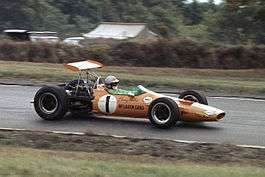
1962 saw Briton Jim Clark win in a Lotus; the next three races were won by fellow-Briton Graham Hill, each time in a BRM. Hill's 1964 win was crucial to him as he carried a points advantage into the next and final race in Mexico. 1966 and 1967 saw Clark win; the '66 win was the only Formula One race he won that year, driving a Lotus with an overweight BRM H16 engine. Both the Drivers' and Constructors' championships were clinched by Australian Jack Brabham and his Brabham team. Clark dominated the 1967 event, leading comfortably from his teammate Hill and American Dan Gurney in an Eagle. In 1968 Mario Andretti put his Lotus 49 on pole position in his first ever Formula One race on a track he had never seen before. Andretti retired, and Briton Jackie Stewart won the race in a Ford/Cosworth powered Matra. Austrian Jochen Rindt won in 1969 – his first Formula One race. He took advantage of Stewart's mechanical problems to pull a huge gap out on the rest of the field. Graham Hill had a much worse day, however. He punctured his car's rear right tire and the rubber came off the rim. The rubber exploded, sending Hill's Lotus cartwheeling off the course, and Hill was thrown out of the car at a very awkward angle, breaking both legs. 1970 was a memorable event, Brazilian newcomer Emerson Fittipaldi won the race, which was his fourth start in a Formula One race. Stewart retired his new Tyrrell and Fittipaldi, driving a Lotus, held off a charge from Mexican Pedro Rodriguez in a BRM. It was a very emotional win for Colin Chapman's Lotus team, as team leader Rindt had been killed while practicing for the Italian Grand Prix at Monza. Lotus had not run the Canadian Grand Prix, but because the next closest championship contender Jacky Ickx did not score enough points to keep him in contention, the Drivers' Championship was won by Rindt posthumously at this race. Team Lotus also won the Constructors' Championship at the 1970 event.

In 1971, the course was changed considerably. The entire lower section of the track was torn up and re-drawn, and there was a whole new "boot" section which added more than a mile to the course, lengthening it to 3.377 miles (5.435 km). It also saw a new pitlane and pit straight and three new corners (a new first, second-to last and last corners). The improvements cost nearly $2.5 million ($13 million in 2010 dollars).[30] The alterations considerably heightened the driving challenge of the track, and it became even more popular than it had been with drivers, teams and fans. Watkins Glen had been transformed from a quick, small circuit into a fast, scenic and very tough up-and-down circuit where just about every corner was banked and long; uncommonly hard driving and maximum effort was required for almost every part of a lap. 1971 was the first running on the completed full circuit (the circuit was not completed in time for previous races, so the completed short circuit was used) and it saw popular Frenchman François Cevert win his only Grand Prix for Tyrrell, and the biggest cash prize in Formula One- $267,000. 1972 saw Jackie Stewart win after Emerson Fittipaldi had already won the championship at the previous race, the Italian Grand Prix at Monza. Cevert made it a Tyrrell 1–2. The race was at this point attracting lots of entries; 30 drivers entered and qualified for the 1972 race.
But from 1973 to 1975, the event reached its probable low. The 1973 Grand Prix was to become a memorable event for all the wrong reasons. Stewart, unknown to almost everyone (even his wife Helen) had planned to retire after this race. He had already won his third Drivers' Championship two races previously at Monza and he would be running his 100th and final Grand Prix. But during qualifying, Stewart's teammate and friend Cevert was killed. Going into the nearly flat out uphill Esses, Cevert went into the first right-hander too fast, clipped the steep curb on the left hand side, lost control, hit Watkins Glen's trademark sky blue Armco on the right side (which on both sides was (and still is) situated right next to the track) and then the Tyrrell started to spin uncontrollably. The car then struck the barrier on the left side nearly head on at 150 mph. The car vaulted and went over the barriers. The barriers cut Cevert in half and he was killed instantly. The Tyrrell was completely destroyed and the right rear tire was sticking over the Armco barriers. South African driver Jody Scheckter tried to get him out- but it was no use; Cevert was so clearly dead. The marshals just left Cevert in the car and threw a cover over the cockpit. A distraught Stewart and his team's manager Ken Tyrrell withdrew the team, handing the Constructors' Championship to Lotus. The illustrious Scotsman never raced competitively again. The race, however, was an exciting one. Swede Ronnie Peterson in a Lotus beat Briton new boy James Hunt in a Hesketh-entered March to the finish by 0.6 of a second. American Peter Revson finished fifth at his home race at his home track.[31] The 1974 event was to decide the world championship between Fittipaldi and Swiss Clay Regazzoni. Both drivers had the same number of points and Regazzoni, driving a Ferrari, ran into a host of problems during the race and finished out of the points. Fittipaldi finished fifth which won him his second Drivers' Championship. The event was marred by yet another fatal accident. The young Austrian Helmut Koinigg crashed at the fast, long Outer Loop corner, the bend after the extended back straight on Lap 10. Koinigg's Surtees went straight on and the car went under the barriers and decapitated Koinigg, killing him instantly.[32] The race was a Brabham 1–2, with Argentine Carlos Reutemann winning with Brazilian Carlos Pace second. 1975 saw a medium speed chicane added to the Esses to slow the cars down, but it did not ruin the flow of the track. The race however, was a politically charged event. Regazzoni held up Fittipaldi's McLaren for six laps and Fittipaldi eventually lapped the Swiss. However, Regazzoni was black flagged by Clerk of the Course Berdie Martin and this irked the ire of Ferrari team manager Luca di Montezemolo. The thin and wiry Montezemolo actually got into a bit of a scuffle with the large Martin; and Montezemolo withdrew Regazzoni in protest. It was not a complete disaster for Ferrari- Austrian and recently crowned Drivers' Champion Niki Lauda went on to win from Fittipaldi.
1976 saw James Hunt win crucially in a McLaren while his closest championship contender Lauda finished third. At this point, Hunt was only three points behind Lauda for the final race at Fuji, Japan. The race also saw Jacky Ickx crash hugely at the Chute, the Belgian survived but was injured. 1977 saw rain throughout the race. Hunt won again on a very wet track as he held off home favorite Mario Andretti in a Lotus 78 to win by two seconds. 1978 saw the heavy-hearted circus arrive after the death of Ronnie Peterson at Monza two weeks before. Andretti had already accumulated enough points to win the Drivers' Championship before coming to Watkins Glen. Mechanical problems forced Andretti to retire early from the race, which was won by Carlos Reutemann in a Ferrari 312T3. 1979 saw Ferrari driver Gilles Villeneuve win a very wet race after Australian Alan Jones retired after dominating much of the race.
But by this time, Watkins Glen had deteriorated from its earlier splendor. Drivers began complaining about the bumpy track surface, and the teams and press were concerned over facilities and rowdy fans.[33] The event started to be attended by drunken, rowdy people who knew little about motor racing and often went to the infamous "Bog", located inside the Boot to set fire to objects and do other destructive things; the Bog was a place where cars and even a Greyhound bus in 1974 were burned just for enjoyment. Even though the Bog was made into a parking lot in 1975, things still did not improve sufficiently over the years. In 1978, the European motorsports governing body, FISA, demanded that the track owners make safety improvements to the track, which were made; and then the event was due to be cancelled for the 1980 season, but it was given a reprieve by FISA after promising to upgrade facilities over the winter.[34] After initially being given an April 13 date on the calendar, the race was moved to October 5.[35][36] Organizers were finally able to secure funding for circuit improvements in late August, and the track was resurfaced.[37] But they still needed a $750,000 loan from FOCA to pay prize money and other expenses.[38] Alan Jones won the exciting 1980 race for Williams after he went off at the first corner on the first lap and charged through the field into second place from 17th, and he ended up taking the checkered flag after pole sitter Bruno Giacomelli retired with electrical problems near the Chute. Reutemann would make it a Williams 1–2, followed by Frenchman Didier Pironi in a Ligier. But this would prove to be the final United States Grand Prix at the Glen. It was initially included on the 1981 calendar, but cancelled after the debts could not be paid and government loans were denied. It was replaced by the Caesars Palace Grand Prix in Las Vegas 2,500 miles away.[38][39]
Other American Grands Prix
In 1976, the Long Beach Grand Prix in the Los Angeles area became a Formula One event, making the United States the first nation since Italy in 1957 to hold two Grands Prix in the same season. The United States Grand Prix West, as it was called to distinguish from the United States Grand Prix East at Watkins Glen, was held until 1983, after which CART became the headliner series. The Caesars Palace Grand Prix in Las Vegas was a non-starter in 1980, debuting in 1981; it would only last two years with Formula One, before CART took over the race for another two seasons. 1982 saw the inaugural Detroit Grand Prix in the center of Detroit, Michigan; making three Formula One races in the United States that year. Detroit would last until 1988, after which it too became a CART event. A one-off Dallas Grand Prix in Fair Park, Texas was held in 1984, which was plagued by problems with the track surface, exacerbated by extremely hot 104 F (40 C) July weather.[40]
A new Grand Prix in the New York City area was announced for the 1983 season, to be held either at the Meadowlands Sports Complex, Meadow Lake in Flushing Meadows, or Mitchel Field in Hempstead, Long Island (on the same site as the 1936 and 1937 Vanderbilt Cups).[41][42] However, the race was first postponed and then cancelled,[43] as CART started their own race at the Meadowlands, and titled it the "United States Grand Prix".[44]
Phoenix
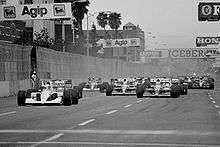
Plans to continue Formula One races in the Detroit area at the nearby Belle Isle Park did not materialize, and in 1989, Formula One moved to the Sonoran Desert city of Phoenix, Arizona.[45] The Phoenix street circuit in the centre of the city was unpopular with drivers and the event was largely ignored by the local populace. Phoenix, like many American cities was designed on the grid system, the circuit was made up entirely of 2nd gear 90-degree corners and provided nearly no driving challenge or exciting corners to watch cars go around. Although the circuit was far less bumpy and a lot wider than Detroit and the circuits long straights made it easy to overtake and difficult to judge braking.
The inaugural event in 1989 was held at short notice and it could only be held in June (Detroit's former date), one of the hottest months of Phoenix – a city with summer temperatures regularly going past 110 °F (43 °C). And of course, temperatures neared 100 °F (38 °C) on that weekend. The race was moved to March for 1990, as the opening round of the season, for the next two years. The McLaren team dominated all three years, with Alain Prost winning in 1989 and Ayrton Senna in 1990 and 1991. The 1989 race saw Prost take advantage of Senna's mechanical woes and 1990 race was notable in that emerging French star Jean Alesi harried Senna for a number of laps; the Tyrrell driver went on to finish second behind Senna. The circuit itself, although changed and made a bit better in 1991, was still unpopular and was still made up of wide, long straights and right-angle corners offered hardly any challenge to the drivers or any spectacle to the audience; this contributed to this event's failure in Phoenix.[46] On October 7, 1991, members of International Auto Sport Federation (FISA) met to discuss the agenda for the 1992 Formula One season, where they voted to cancel the contract with city of Phoenix. That same year, Phoenix mayor David Garcia said the city lost $1.3 million dollars and was in negotiations with Ecclestone on contract cancelation.[47] Formula 1 event would not be held in United States until year 2000.
Indianapolis Grand Prix
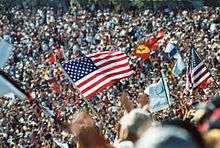
It was not until 2000 that another United States Grand Prix took place, this time at the legendary Indianapolis Motor Speedway in Indiana. Indianapolis was rumored to have been considering a Formula One race since the USGP left Phoenix.[48] The 2.606-mile (4.194 km) infield road course uses about a mile of the oval, but in a clockwise direction. The crowd at the 2000 race was estimated at over 225,000, perhaps the largest ever in F1.[49] Michael Schumacher's win was his second of four straight to end the season as he overtook Mika Häkkinen for his third Championship. In 2001, the race took place less than three weeks after the events on September 11, 2001 in the US, and many teams and drivers featured special tributes to the USA on their cars and helmets. The 2002 edition was known for Schumacher and teammate Rubens Barrichello trading places near the finish line after Schumacher's failed bid to end the race into a dead heat with Barrichello. Held in September its first four years (in order to distance it from the "500" and NASCAR's Brickyard 400), the USGP at Indianapolis was moved to an early summer date in 2004 in late June, 3 weeks after the Indy 500 so it could be paired with the Canadian Grand Prix and to make room for new Asian rounds. In 2005, problems with Michelin tires led to seven teams withdrawing from the race after the formation lap. Only the three teams (six cars) with Bridgestone tires started the 2005 United States Grand Prix, and the event was considered a farce.[50] Many commentators questioned whether a United States Grand Prix would be held in Indianapolis again, but the 2006 United States Grand Prix was held the next year, on July 2, 2006, without controversy.

On July 12, 2007, Formula One and the Indianapolis Motor Speedway announced that the 2007 U.S. Grand Prix would be the last one held at IMS for the foreseeable future, as both sides could not agree on the terms for the event.[51] It was thought that the race would return to Indianapolis for 2009 on the track configuration that was used for the 2008 race in the MotoGP championship.[52] Then-Indianapolis Motor Speedway CEO, Tony George, claimed that the USGP would not return to Indianapolis unless it made financial sense. Due to the expensive fees paid to host a grand prix, the race would require a title sponsor to be economically viable.[53] Ultimately, the United States Grand Prix was not on the Formula One calendar for 2009.
Austin
In August 2009, Formula One president Bernie Ecclestone remarked that there was no immediate plan to return Formula One to the US, vowing "never to return" to Indianapolis.[54] Nevertheless, shortly before the first race of the 2010 season, Ecclestone continued to fuel speculation that a return to Indianapolis was not out of the question.[55] In March 2010, Ecclestone announced plans to bring a Formula One race to New York City for the 2012 season. Ecclestone was quoted as saying the race would take place across the Hudson River in New Jersey, with the Manhattan skyline overlooking the circuit.[56] In May 2010, plans emerged for a circuit to be built in Jersey City's Liberty State Park,[57][58] but those plans were abandoned shortly thereafter.[59] A race in West New York and Weehawken was later announced in October 2011. In May 2010, it was announced that Monticello Motor Club – a circuit complex modeled on a private country club near Monticello – had submitted a bid for the rights to host the race.[60]
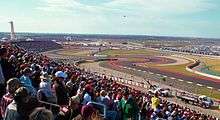
On May 25, 2010, Austin, Texas, was awarded the race on a ten-year contract, as Ecclestone and event promoter Full Throttle Productions agreed to a deal beginning in 2012. The event is being held on a purpose-built new track, which was named Circuit of the Americas.[61] German architect and track designer Hermann Tilke designed the new track on 800 acres (320 ha) of land to the east of the city.[62] In July 2010, promoter Tavo Hellmund promised that the circuit would be one of the "most challenging and spectacular in the world" and that it would include a selection of corner sequences inspired by "the very best circuits" in the world.[63]
On November 15, 2011, it was reported that construction of the circuit had been temporarily halted as the owners had not yet been awarded the contract to stage the race in 2012,[64] following reports that Bernie Ecclestone had cast doubt on the race taking place.[65][66][67] After Tavo Hellmund's contract was found in breach by Ecclestone[68] and a new contract was entered into between Formula 1 and the original track investors, Red McCombs and Bobby Epstein, the U.S. Grand Prix was confirmed to be held at the Circuit of the Americas in Austin on the original scheduled date in 2012.[69][70] Reigning champion Sebastian Vettel took pole for the 1st race at the Texas circuit but it was 2007 winner Lewis Hamilton who kept his unbeaten run in the USA as the two finished almost 40 seconds ahead of third.
The Grand Prix in Austin has proven to be a considerable success, thanks to the Texas capital's growing reputation as a center of music and culture, its friendly citizens and unique atmosphere during the race weekend. It has been lauded from all quarters of Formula One.[71]
The event in recent years has been plagued with declining fan attendance. With the return of the Mexican Grand Prix, many of the Formula 1 fans from Mexico will be attending the race in Mexico City. The race is however in jeopardy. On November 11, 2015, the Texas government cut nearly $6 million of the required $25 million in funding to host the event. After the events of the 2015 United States Grand Prix, it was a big blow to the funding of the event. On March 9, 2016, it was confirmed the race would continue to run in Austin, despite the funding cuts. 2016 turned out to be the best-attended Grand Prix in Austin: boosted by a heated World Drivers' Championship battle between Lewis Hamilton and Nico Rosberg, good weather, and the allure of a Saturday night concert from pop singer Taylor Swift, just shy of 270,000 people went through the turnstiles during the race weekend.[72]
Winners
Events which were not part of the Formula One World Championship are indicated by a pink background.
Notes:
- From 1908 to 1916, the race was named the American Grand Prize.
- A total of six American drivers have won the United States Grand Prix, all except one when it was known as the American Grand Prize, which was not part of the Grand Prix calendar. Chuck Daigh also won it as a non-championship race at Riverside in 1958. But while the event has been part of the Formula One World Championship, no American has won the event; however Mario Andretti won the 1977 United States Grand Prix West in Long Beach, California.
Multiple winners (drivers)
Embolded drivers are still competing in the Formula One championship
A pink background indicates an event which was not part of the Formula One World Championship.
| # Wins | Driver | Years won |
|---|---|---|
| 5 | |
2000, 2003, 2004, 2005, 2006 |
| |
2007, 2012, 2014, 2015, 2016 | |
| 3 | |
1963, 1964, 1965 |
| |
1962, 1966, 1967 | |
| 2 | |
1910, 1911 |
| |
1968, 1972 | |
| |
1976, 1977 | |
| |
1974, 1978 | |
| |
1990, 1991 |
Multiple winners (constructors)
Embolded teams are still competing in the Formula One championship
A pink background indicates an event which was not part of the Formula One World Championship.
| # Wins | Constructor | Years won | |
|---|---|---|---|
| 9 | |
1975, 1978, 1979, 2000, 2002, 2003, 2004, 2005, 2006 | |
| 8 | |
1960, 1961, 1962, 1966, 1967, 1969, 1970, 1973 | |
| |
1976, 1977, 1989, 1990, 1991, 2001, 2007, 2012 | ||
| 4 | |
1910, 2014, 2015, 2016 | |
| 3 | |
1908, 1911, 1912 | |
| |
1963, 1964, 1965 | ||
| 2 | |
1915, 1916 | |
| |
1971, 1972 | ||
By year
A pink background indicates an event which was not part of the Formula One World Championship.
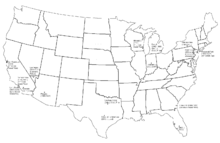
Title sponsors
- 1977–1980: Toyota United States Grand Prix
- 1989–1991: Iceberg United States Grand Prix
- 2000–2002: SAP United States Grand Prix
- 2003–2005: Foster's United States Grand Prix
Previous circuits used
.svg.png) Sebring (1959)
Sebring (1959)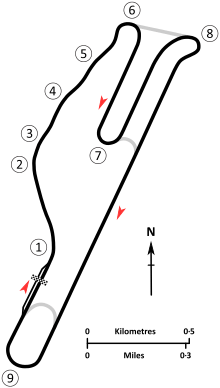 Riverside (1960)
Riverside (1960) Watkins Glen (1961–1970)
Watkins Glen (1961–1970) Watkins Glen (1971–1974)
Watkins Glen (1971–1974) Watkins Glen (with Esses chicane) (1975–1980)
Watkins Glen (with Esses chicane) (1975–1980)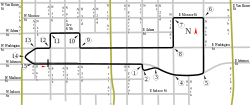 Phoenix (1989–1990)
Phoenix (1989–1990)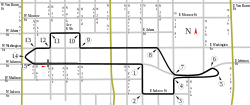 Phoenix (1991)
Phoenix (1991) Indianapolis Motor Speedway (2000–2007)
Indianapolis Motor Speedway (2000–2007)
Notes
- 1 2 "Formula1.com Races in Detail: 2012 Formula 1 United States Grand Prix". Retrieved June 14, 2012.
- 1 2 Etzrodt, Hans (June 19, 2007). "Grand Prix Winners 1895–1949. History and Formulae.". Retrieved February 18, 2011.
- ↑ "Foreign Autoists Eager for Racing". The New York Times. January 6, 1908. Archived from the original (PDF) on April 30, 2011. Retrieved February 18, 2011.
- ↑ "Auto Agreement Announced by A.C.A.". The New York Times. September 22, 1908. Archived from the original (PDF) on April 30, 2011. Retrieved February 18, 2011.
- 1 2 Nye 1978, p. 12
- ↑ "Men Who Will Strive for the Grand Prize at Savannah". The New York Times. November 1, 1908. Archived from the original (PDF) on April 28, 2011. Retrieved February 18, 2011.
- ↑ Nye 1978, pp. 13–14
- ↑ Nye 1978, pp. 16–18
- ↑ Nye 1978, p. 26
- ↑ Nye 1978, p. 25
- ↑ Nye 1978, pp. 26–28
- ↑ Nye 1978, pp. 29–31
- ↑ Nye 1978, pp. 32–33
- ↑ Nye 1978, p. 34
- ↑ Printz, John G.; Ken H. McMaken. "U.S. 1894–1920: Short History".
But the substitution ploy, Aitken for Wilcox, failed completely as the AAA refused to give Aitken any points at all. Nor did Resta or Rickenbacker gain any AAA points in the Grand Prize. Wilcox however, as the starting driver, was awarded 438 points for the 20 laps he drove in the winning Peugeot.
- ↑ "Championship Auto Races for 1917". The New York Times. March 18, 1917. Archived from the original on April 30, 2011. Retrieved April 30, 2011.
- 1 2 3 4 5 6 Capps, Don; Cameron Argetsinger (October 25, 2000). "Where Upon Our Scribe, Sherman, & Mr. Peabody Once Again Crank Up The Way-Back Machine for 1961..". AtlasF1. Rear View Mirror. 6 (43). Archived from the original on May 1, 2011. Retrieved May 1, 2011.
- ↑ Washington Post. December 16, 1928. p. A5.
The Indianapolis 500-mile race hereafter will be known as the Grand Prize of America. A permanent challenge trophy, commemorative of the place that the premier American speedway event has in auto racing annals, was authorized, effective this year.
Missing or empty|title=(help) - ↑ "AAA Contest Board Official Bulletin". February 14, 1930.
GRAND PRIX TROPHY – A most pleasant surprise was the announcement by Mrs. George H. Fearons, Jr. at the January meeting of the Contest Board that Automobile Club of America had decided again to place the Grand Prix Gold Cup in competition. This famous old trophy had been on display in the foyer of the ACA headquarters since 1916, when it was last raced for at the Santa Monica Grand Prix Road Race. A new deed of gift has been prepared whereby it will be annually awarded the winner of the Indianapolis "500" and will be loaned the winner upon posting satisfactory bond until one month before the next year's race.
- 1 2 Nye 1978, p. 47
- ↑ "USAC Road Racing Championship 1958". World Sports Racing Prototypes. Retrieved May 1, 2011.
- ↑ "Riverside – List of Races". Racing Sports Cars. Retrieved May 1, 2011.
- ↑ Capps, Don (June 16, 1999). "1959: Part 4, Monza and Sebring". AtlasF1. Rear View Mirror. 5 (24). Archived from the original on May 1, 2011. Retrieved May 1, 2011.
- ↑ "Sebring Race Still Scheduled". St. Petersburg Times. AP. February 14, 1959. Retrieved May 1, 2011.
- ↑ Nye 1978, p. 46
- ↑ Nye 1978, p. 39
- ↑ Nye 1978, p. 53
- ↑ Nye 1978, p. 85
- ↑ Nye 1978, pp. 99–100
- ↑ Britt, Bloys (September 26, 1971). "29 Drivers To Test New Track". The Press-Courier. Oxnard, California. p. 28. Retrieved May 16, 2011.
- ↑ "François Cevert". Motorsport Memorial. Retrieved May 16, 2011.
- ↑ "Helmuth Koinigg". Motorsport Memorial. Retrieved May 16, 2011.
- ↑ "Watkins Glen may lose". The Spokesman-Review. Spokane, Washington. November 17, 1979. p. 24. Retrieved May 17, 2011.
- ↑ "Grand Prix Alive at Watkins Glen". The Star-Phoenix. Saskatoon. AP. December 13, 1979. p. D4. Retrieved May 17, 2011.
- ↑ "Watkins Glen Will Be Site For Grand Prix". The Times-News. Hendersonville, North Carolina. AP. February 4, 1980. p. 9. Retrieved May 17, 2011.
- ↑ Harris, Mike (March 24, 1980). "Long Beach hosts event". The Rock Hill Herald. Rock Hill, South Carolina. AP. p. 6. Retrieved May 17, 2011.
- ↑ "Watkins Glen May Have Found 'Angel'". Schenectady Gazette. AP. August 29, 1980. p. 17. Retrieved May 17, 2011.
- 1 2 "Watkins Glen loses sanction". Boca Raton News. AP. May 8, 1981. p. 10B. Retrieved May 16, 2011.
- ↑ "Last-ditch effort fails to save U.S. Grand Prix". The Gazette. Montreal. AP. June 25, 1981. p. 19. Retrieved May 18, 2011.
- ↑ Schot, Marcel (September 20, 2000). "The 1984 United States GP {{sic}}". AtlasF1. A Race to Remember. Kaizar.Com, Incorporated. 6 (38). Retrieved May 16, 2011.
- ↑ "New York May Get '83 Auto Grand Prix". The New York Times. October 28, 1982. Retrieved May 18, 2011.
- ↑ "New York Grand Prix scheduled". Reading Eagle. UPI. October 28, 1982. pp. 41, 47. Retrieved May 18, 2011.
- ↑ "No auto racing in New York". Boca Raton News. June 3, 1983. p. 2D. Retrieved May 18, 2011.
- ↑ Harris, Mike (June 29, 1984). "U.S. Grand Prix success is vital to CART future". Daily News. Bowling Green, Kentucky. AP. p. 1–B. Retrieved May 18, 2011.
- ↑ Siano, Joseph (January 30, 1989). "Auto Racing; Grand Prix Moves to Phoenix". The New York Times. Archived from the original on May 18, 2011. Retrieved May 18, 2011.
- ↑ Phoenix may lose formula one race, Mel Reisner Associated Press sports writer October 9, 1991
- ↑ "Phoenix may lose Formula One auto race". Kingman Daily Miner. October 7, 1991. Retrieved June 29, 2016.
- ↑ Newberry, Paul (May 28, 1994). "Indianapolis will be successful, despite additions". Sun-Journal. Lewiston, Maine. AP. p. 20. Retrieved May 18, 2011.
- ↑ "Schumacher trounces the field in Grand Prix". The Vindicator. Youngstown, Ohio. AP. September 25, 2000. p. C3. Retrieved May 19, 2011.
- ↑ "Schumacher claims farcical US win". BBC. June 19, 2005. Retrieved May 19, 2011.
- ↑ Caldwell, Dave (July 13, 2007). "Grand Prix Is Making A U-Turn From Indy". The New York Times. Retrieved May 19, 2011.
- ↑ Autosport: 11. March 27, 2008. Missing or empty
|title=(help) - ↑ "F1: USGP Needs Title Sponsor to Return". SPEEDTV.com. March 28, 2008. Archived from the original on January 30, 2011. Retrieved January 30, 2011.
- ↑ "Ecclestone eyes Canada Grand Prix for 2010". AFP. August 4, 2009. Archived from the original on January 30, 2011. Retrieved January 30, 2011.
- ↑ "F1: Indianapolis Admits US GP Return Possible". SPEEDTV.com. March 15, 2010. Archived from the original on January 30, 2011. Retrieved January 30, 2011.
- ↑ Lostia, Michele (March 25, 2010). "Ecclestone hoping for New York GP". Autosport.com.
- ↑ Collantine, Keith (May 4, 2010). "New York F1 track plans revealed – Jersey City bids for 2012 night race". F1 Fanatic. Archived from the original on January 30, 2011. Retrieved May 4, 2010.
- ↑ Noble, Jonathan (May 4, 2010). "Jersey City eyes Formula 1 race". Autosport.com.
- ↑ Elizalde, Pablo (May 5, 2010). "Jersey City cans F1 grand prix plan". Autosport.com.
- ↑ Collantine, Keith (May 22, 2010). "Monticello Motor Club making United States Grand Prix bid". F1 Fanatic. Archived from the original on January 30, 2011. Retrieved May 22, 2010.
- ↑ "Formula One returns to the United States". formula1.com. Formula One Administration. May 25, 2010. Archived from the original on January 30, 2011. Retrieved May 25, 2010.
- ↑ Cooper, Adam (May 26, 2010). "Tilke designing Austin track, site already purchased". Adam Cooper's F1 blog. Archived from the original on January 30, 2011. Retrieved May 26, 2010.
- ↑ Noble, Jonathan (July 15, 2010). "Austin promises unique F1 circuit". Autosport.com.
- ↑ "Work on United States Grand Prix track halted". BBC News. November 16, 2010.
- ↑ "US race chief bemused after Ecclestone doubts Austin race". BBC News. November 13, 2010.
- ↑ Cooper, Adam. "Austin race on the verge of cancellation, Ecclestone admits". Autoweek. Retrieved November 17, 2011.
- ↑ Cooper, Adam (November 30, 2011). "Formula One: U.S. GP in Austin gets deadline extension from Bernie Ecclestone". Autoweek. Retrieved December 1, 2011.
- ↑ Cooper, Adam. "Exclusive: Bernie Ecclestone talks to Autoweek about Austin Grand Prix". Autoweek. Crain Communications, Inc. Archived from the original on February 21, 2012. Retrieved February 21, 2012.
- ↑ "Sports News | Wide World of Sports – ABC News". Abcnews.go.com. Retrieved November 17, 2013.
- ↑ Pugmire, Jerome (December 7, 2011). "US Grand Prix included in F1 calendar for 2012". Boston.com. NY Times Co. AP. Archived from the original on February 21, 2012. Retrieved February 14, 2012.
- ↑ "A month in the life of Motor Sport". motorsportmagazine.com. Retrieved October 26, 2015.
- ↑ George, Patrick. "More People Attended Austin's F1 Race Weekend Than Ever Before". jalopnik.com. Retrieved October 29, 2016.
References
- Nye, Doug (1978). The United States Grand Prix and Grand Prize Races, 1908–1977. Garden City, N.Y.: Doubleday. ISBN 978-0-385-14203-8.
- "2012 US Grand Prix winners Trophies revealed – A sign of precision, pace and Texas", Formula1Onlive, Retrieved on November 1, 2012.
External links
| Wikimedia Commons has media related to United States Grand Prix. |